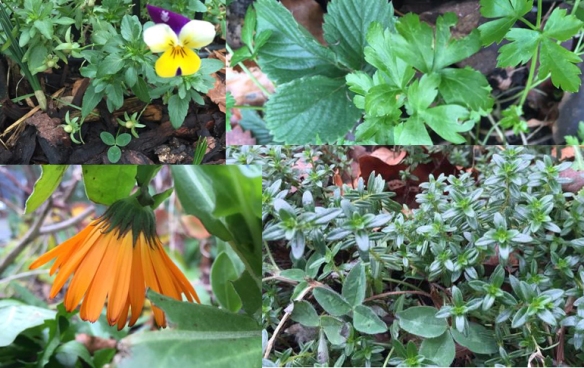When I first started blogging, I decided not to blog about me. For more than a year, that worked really well. But then something happened. And it changed everything.

Photos from the garden yesterday afternoon. Call this winter? At ankel’s height there’s still lots to see. Bulbs reaching up. A cold snap with a drizzle of snow caused stubborn flowers to droop.
Over a year ago I got a new job. In content management. A great opportunity to turn all my talk about content, social media, and the like, into my daily job.
But somehow, spending hours at work fiddling with texts doesn’t motivate one to sit down at night and do the same thing all over again. Writing about content wasn’t the only problem. It was the editing, finding the right picture, and so on.
And even ‘writing about content’ was turning into a problem. Because it was ‘work’. I don’t mind work, I just don’t need to do one thing anywhere near 24/7. I craved variety. I’ve always loved doing a lot of different things at (nearly) the same time. (I know it’s getting out of hand whenever there are three different books by my bedside and another (two or three) in the living room.)
Content to garden
Then a new topic to blog about crossed my path. My garden. Actually it wasn’t that much of a garden: it was what was left after the houses had been built. After removing most of that one plant species I later learned is called lady’s thumb, because it grew nearly two feet tall all over the place, I let the other stuff grow to find out what kind of weed it was:
- nice (like the flowery ones)
- educational (stinging nettles – our son never had accidents with them at home)
- slightly annoying (dandelions, but making up for it by looking great)
- a real pain – unless you find a use for it (horsetail)
I’d added some plants but never sat down to decide which bigger plants might really add structure to our garden. It almost felt impossible to put big plants into a small garden. Partially because it would mean ripping out weeds that had grown on me. Sort of. Some of them. Partially because, well, it’s a small garden. Big plants were never going to fit, right?
Garden changes
But here I am after trying stuff in my garden for a whole growing season. I put in bigger plants and I keep seeing patches where more plants would fit quite snugly. I also started blogging about my garden.
Looking back at some pictures I took a few years ago I noticed one thing. A lot of small plants have disappeared. Having bigger plants shade the soil and soaking up nutrients and water has probably meant that the smaller ‘pioneer’ plants have left – after depositing their seeds in case a big shrub or a treelet is uprooted by a storm.
I’ve been able to retain a red clover, so hopefully it will attract bees and the like next spring. The gaps left by the pioneer plants are now begging for inhabitants -they are an open invitation for our neighbors’ cat to crap right in that spot (they don’t have a garden. Just a place to sit outside. And a cat with toilet issues). That’s one thing about some of the herbs: they die back when it gets cold and then the cats move in. Plants with woody stems are better.
Looking forward to spring. Happy New Year!









